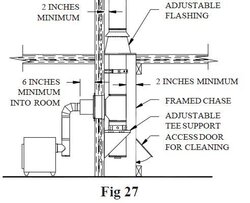Hello everyone, I joined up to ask you a question on my new stove. I had this stove professionally installed and recently fired it up for its first fire. I am concerned about my chimney getting too hot. The pipe from the stove is black and appears to be a single wall pipe and I expect it to be hot. This pipe then goes through a wall and joins a wider diameter, polished stainless pipe which I presume is insulated and double walled. It then runs through a guest room upstairs before going through the roof.
With a normal firing burning, the stainless pipe in the upstairs room is very hot to the touch. I can brush my hand on it briefly without burning my self, but if I kept it there any longer I would likely get burned. It is definitely not safe for children which will be a likely scenario for me.
Is this normal? How hot does your insulated chimney become? Can I enclose this chimney safely (label says 2 inch minimum clearance to combustibles)
With a normal firing burning, the stainless pipe in the upstairs room is very hot to the touch. I can brush my hand on it briefly without burning my self, but if I kept it there any longer I would likely get burned. It is definitely not safe for children which will be a likely scenario for me.
Is this normal? How hot does your insulated chimney become? Can I enclose this chimney safely (label says 2 inch minimum clearance to combustibles)



